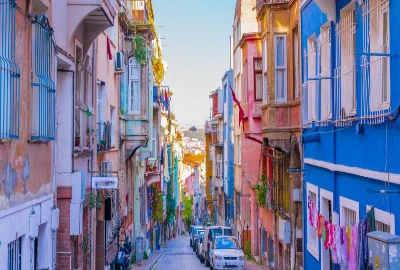Festivals You Don’t Watch — You’re Part of the Show

When most people think about festivals, they picture parades to watch, concerts to attend, or cultural performances to admire from a safe distance. But some of the most unforgettable celebrations in the world don’t allow you to be a passive spectator—they pull you directly into the heart of the action. These immersive experiences blur the line between performer and audience. Whether you’re covered in powder, soaked in water, or dancing in the street with thousands of strangers, you don’t just watch these festivals—you live them.
This type of cultural celebration leaves a mark because it demands your full presence. You’re not just clicking photos from the sidelines; you’re drenched in color at Holi in India, slipping through tomato pulp at La Tomatina in Spain, or dancing for hours during Brazil’s Carnival. Travelers often say these experiences feel like stepping into a dream or movie scene, only better, because you’re part of it.
In this blog, we’ll explore some of the most famous—and delightfully chaotic—festivals you don’t watch, you’re part of the show. We’ll cover what makes them unique, what to expect, and practical tips for joining in.
Holi in India: A Riot of Colors
Holi is more than just a festival—it’s a burst of joy, tradition, and chaos wrapped in color. Celebrated every spring, usually in March, it marks the victory of good over evil and the arrival of warmer days. But for travelers, Holi is remembered not for mythology but for its energy. You simply cannot remain a bystander during Holi. The moment you step outside, handfuls of powdered colors fly through the air, water balloons splash across streets, and strangers smear your face with vivid pinks, blues, and greens.
The magic of Holi lies in its inclusivity. It dissolves social and cultural barriers, encouraging people of all ages, classes, and backgrounds to come together in play. Tourists are not just welcome but actively invited into the fun. Children will run up to you with mischievous grins, families will offer you sweets, and groups of young people will pull you into dance circles on the street. The atmosphere is one of pure abandon—music blaring, drums pounding, and laughter ringing everywhere.
Participating in Holi also gives you a deeper connection to Indian culture. The colors symbolize joy and unity, while the act of throwing them is believed to erase differences. There’s also a strong element of community—sharing food, dancing together, and letting go of worries.
Travel tip: If you’re planning to join, wear old clothes you’ll never need again—powder dye is nearly impossible to wash out. Protect your hair and skin with coconut oil, and use waterproof covers for phones and cameras. But most importantly, let go of expectations and embrace the chaos. Holi is not about looking neat—it’s about surrendering to joy.

La Tomatina in Spain: The World’s Biggest Food Fight
Held in the small Valencian town of Buñol, La Tomatina is perhaps the messiest festival on Earth. Every August, tens of thousands of people gather to throw overripe tomatoes at one another for exactly one hour. What began as a local prank in 1945 has grown into an internationally renowned event that attracts participants from around the world.
When the trucks roll in carrying tons of tomatoes, the town square transforms into a battlefield. Once the starting signal goes off, chaos unfolds—tomatoes fly through the air, splattering clothes, walls, and faces. Within minutes, everyone is dripping with pulp, slipping on red-soaked streets, and laughing uncontrollably. Unlike parades or performances where you stand back and observe, here you’re right in the thick of it. There’s no option to stay clean; being part of the mayhem is the whole point.
The appeal of La Tomatina lies in its sheer absurdity. There is no deep spiritual meaning or historical symbolism—it’s about letting go of social norms, doing something outrageous, and embracing fun with strangers. For many, the festival feels like being part of a giant, joyful prank. Tourists often leave saying it was one of the most freeing experiences of their travels, precisely because it’s so unlike anything else in daily life.
The event is so popular that the local government now sells tickets to regulate crowd size, making it safer and more manageable. Beyond the tomato fight, Buñol hosts parades, fireworks, and street parties, so the experience extends beyond just the food fight itself.
Travel tip: Goggles are essential. Tomato juice burns if it gets in your eyes. Wear old shoes with good grip—streets get slippery fast. And remember: once the festival ends, fire hoses wash the town clean, but you’ll be carrying tomato stains (and memories) long after.

The Songkran Water Festival in Thailand: A City-Wide Splash
Songkran, Thailand’s New Year celebration, takes place every April and is one of the most immersive festivals in Southeast Asia. Traditionally, Songkran involved gently pouring water over Buddha statues and elders to symbolize purification and blessings for the year ahead. Today, that ritual has evolved into a nationwide water fight that transforms entire cities into splash zones.
For three to five days, streets in Bangkok, Chiang Mai, Phuket, and nearly every Thai town become arenas for water battles. Locals arm themselves with water guns, hoses, and buckets, while vendors sell waterproof phone cases on every corner. Tourists are immediately swept into the fun—if you step outside, you will be soaked within minutes. Pickup trucks drive by with barrels of ice water, soaking pedestrians, while music and street food keep the celebrations lively late into the night.
The beauty of Songkran is that it balances tradition and modern fun. You’ll see people still visiting temples for blessings in the morning, and then hours later, those same streets erupt into massive water fights. It’s both sacred and playful, giving travelers a glimpse into Thai culture while also offering one of the most joyful travel experiences imaginable.
Participating in Songkran also breaks down barriers between locals and visitors. Everyone is equal when they’re armed with water guns, and it’s impossible not to laugh when you’re suddenly hit with a freezing splash.
Travel tip: Protect valuables with waterproof bags, and keep only essentials on you. Wear light clothing that dries quickly. Embrace getting soaked from head to toe—it’s not optional, it’s the point.

Carnival in Brazil: Parades You Don’t Just Watch
The Rio Carnival is often thought of as a dazzling performance to be admired from the stands of the Sambadrome, but what many travelers don’t realize is that much of the magic happens in the streets. Beyond the samba schools competing in choreographed parades, the city itself becomes one giant party.
Street parades known as blocos bring Carnival to every neighborhood, and this is where visitors truly join the celebration. Costumes range from extravagant feathered outfits to playful homemade designs, and the music is irresistible. You can’t just stand and watch—crowds sweep you up into samba circles, conga lines, and endless waves of dancing. For days, Rio pulses with nonstop energy, and whether you’re a skilled dancer or just moving awkwardly to the rhythm, you’re embraced as part of the celebration.
Carnival is more than just a party; it’s a cultural expression of joy, resilience, and community. The samba tradition carries deep Afro-Brazilian roots, and the festival itself reflects Brazil’s diversity and spirit. For tourists, being part of Carnival is not just fun but also a cultural education—an invitation to live the rhythm of Brazil rather than merely observe it.
Travel tip: Join a bloco rather than sticking only to the Sambadrome shows. Bring comfortable shoes, hydrate often, and be ready for long days (and nights) of dancing. Most importantly, come with an open spirit—Carnival is about connection as much as celebration.

The Cooper’s Hill Cheese-Rolling in England: Racing for Tradition
On the surface, cheese-rolling in Gloucestershire may seem like a quirky tradition best left to watch. But the festival, held annually on Cooper’s Hill, thrives because of its chaotic participation. Competitors chase a rolling wheel of cheese down a dangerously steep slope, often tumbling, tripping, and colliding in the process.
For participants, it’s a mix of adrenaline and absurdity. The cheese can reach speeds of up to 70 mph, and the hill is so steep that most people don’t actually run—they fall. Injuries are common, but so are bursts of laughter and cheering. For spectators, the thrill isn’t just watching others tumble—it’s joining the event, running if you dare, or at least being part of the raucous community cheering at the bottom.
The charm of cheese-rolling lies in its unpolished, authentic spirit. Unlike large-scale festivals, it feels raw and personal, rooted in centuries of tradition. You don’t need to be an athlete to participate; you just need a willingness to laugh at yourself and embrace the madness.
Travel tip: If you plan to race, expect bruises and mud. If not, wear sturdy shoes, bring a picnic, and enjoy the lively atmosphere—it’s one of the quirkiest cultural traditions you’ll ever witness.

Why These Festivals Resonate So Deeply
Festivals like Holi, La Tomatina, Songkran, Carnival, and cheese-rolling stand out because they erase the spectator-performer divide. They remind us that culture isn’t static—it’s participatory. As a traveler, joining these events offers something no museum or guided tour can: the chance to be part of living traditions, surrounded by laughter, chaos, and shared joy.
In an era when tourism can sometimes feel staged or distant, these festivals offer authenticity. You’re not observing locals celebrate—you’re celebrating alongside them. And that creates stories you’ll carry for a lifetime.




